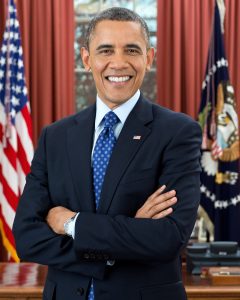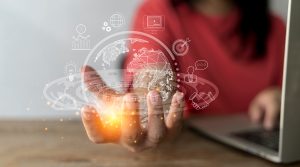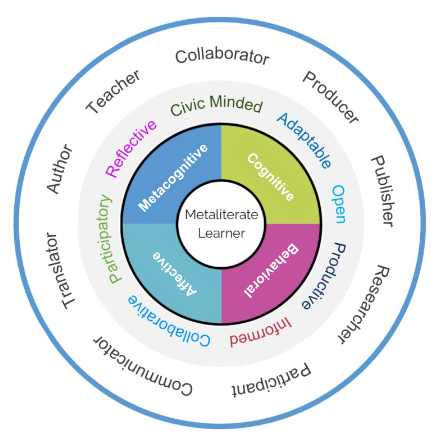1 Information and New Literacies Theory: Theories of Information Literacy, Digital Literacy, Transliteracy/Metaliteracy, and Visual Literacy
Theories of information literacy, digital literacy, transliteracy/metaliteracy, and visual literacy
What is Information Literacy?
According to the American Library Association (ALA), information literacy is the set of skills needed to find, retrieve, analyze, and use information. Information Literacy is so important that on October 1, 2009, President Barack Obama declared that National Information Literacy Awareness Month would be observed each October. Read the President’s proclamation below:

NATIONAL INFORMATION LITERACY AWARENESS MONTH, 2009
BY THE PRESIDENT OF THE UNITED STATES OF AMERICA
A PROCLAMATION
Every day, we are inundated with vast amounts of information. A 24-hour news cycle and thousands of global television and radio networks, coupled with an immense array of online resources, have challenged our long-held perceptions of information management. Rather than merely possessing data, we must also learn the skills necessary to acquire, collate, and evaluate information for any situation. This new type of literacy also requires competency with communication
technologies, including computers and mobile devices that can help in our day-to-day decision-making. National Information Literacy Awareness Month highlights the need for all Americans to be adept in the skills necessary to effectively navigate the Information Age.
Though we may know how to find the information we need, we must also know how to evaluate it. Over the past decade, we have seen a crisis of authenticity emerge. We now live in a world where anyone can publish an opinion or perspective, whether true or not, and have that opinion amplified within the information marketplace. At the same time, Americans have unprecedented access to the diverse and independent sources of information, as well as institutions such as libraries and universities, that can help separate truth from fiction and signal from noise.
Our Nation’s educators and institutions of learning must be aware of — and adjust to — these new realities. In addition to the basic skills of reading, writing, and arithmetic, it is equally important that our students are given the tools required to take advantage of the information available to them. The ability to seek, find, and decipher information can be applied to countless life decisions, whether financial, medical, educational, or technical.
This month, we dedicate ourselves to increasing information literacy awareness so that all citizens understand its vital importance. An informed and educated citizenry is essential to the functioning of our modern democratic society, and I encourage educational and community institutions across the country to help Americans find and evaluate the information they seek, in all its forms.
NOW, THEREFORE, I, BARACK OBAMA, President of the United States of America, by virtue of the authority vested in me by the Constitution and the laws of the United States, do hereby proclaim October 2009 as National Information Literacy Awareness Month. I call upon the people of the United States to recognize the important role information plays in our daily lives, and appreciate the need for a greater understanding of its impact.
IN WITNESS WHEREOF, I have hereunto set my hand this first day of October, in the year of our Lord two thousand nine, and of the Independence of the United States of America the two hundred and thirty-fourth.
As President Obama’s proclamation stated, information literacy forms the basis of lifelong learning and is necessary for completing tasks such as applying for a job or even performing your job, emailing your professor, or attending classes and is essential for navigating our daily lives. Developing information literacy skills helps us to help our students and patrons as they maneuver through the journey of gaining experience in locating, evaluating, organizing, using, and communicating information.
The previous standards used for teaching information literacy competencies were the Association of College & Research Libraries (ACRL) Information Literacy Competency Standards.
ACRL Information Literacy Competency Standards
According to the ACRL Information Literacy Competency Standards, an information literate individual is able to:
- Determine the extent of information needed
- Access the needed information effectively and efficiently
- Evaluate information and its sources critically
- Incorporate selected information into one’s knowledge base
- Use information effectively to accomplish a specific purpose
- Understand the economic, legal, and social issues surrounding the use of information, and access and use information ethically and legally
While these standards are still incredibly useful for helping learners complete specific kinds of information tasks, these standards focused on the hard skills necessary to meet an information need. They are a set of skills that can be learned by performing information tasks, and the respective performance of these types of information tasks improves fluency. However, the core ideas that make up the foundation of information literacy education has evolved, so higher education and information literacy education have evolved as well.
The ACRL Framework for Information Literacy for Higher Education, adopted in 2016, is “called a framework intentionally because it is based on a cluster of interconnected core concepts, with flexible options for implementation, rather than on a set of standards or learning outcomes, or any prescriptive enumeration of skills” (ACRL, 7). This framework comprised of six frames made up of knowledge practices and dispositions of learners at varying levels of experience with each frame.
ACRL Framework for Information Literacy for Higher Education
For example, the frame “Scholarship as Conversation,” refers to the “conversation” that is occurring when users, often researchers, publish and respond to the works of other scholars. It is important to remember and to remind students that they too are taking part in this conversation every time they write an essay that responds to existing scholarship.
Framework Matching
There are many other standards that exist, including individual state standards for both K-12 and Higher Education, including the American Association of School Librarians Standards and the AASL Standards Crosswalks that act as a roadmap to allow school librarians and educators to move seamlessly between the AASL Standards and other learning standards.
What is Digital Literacy?

Digital literacy is the ability to find, evaluate, utilize, share, and create content using information technologies and the Internet. In the following resource, “What Is Digital Literacy,” a library research guide (LibGuide) from Bow Valley College, the fundamental components of digital literacy are discussed, including a combination of functional, creative, and critical thinking skills. Understanding the internet, computer algorithms, and how to use computer operating systems and software are all necessary concepts to learn and eventually master. “Netiquette,” an unofficial, socially constructed set of rules for respectful behavior when communicating online, especially through email, is another unique skill set that can change depending on format, context, and your relationship with the person you are communicating with digitally. As time passes, socially accepted ideas of what constitutes good, polite digital communication changes; generationally, many younger users, or even older, less digitally literate users may have very different ideas about what is considered good, internet etiquette.
While the information in this guide might seem like common knowledge, and although the percentage of people who are digitally literate varies widely by age, level of education, race, and ethnicity, according to the U.S. Department of Education and Institute for Education Statistics, 16% of U.S. adults of working age are not digitally literate, compared to 23% worldwide.
Google Search Tips
The following video from Brett In Tech (2021), “Google Search Tips & Trips That Get You Better Results!” can help searchers improve their searching abilities by improving their queries, and teaching them the symbols and operators that refine their results.
Plagiarism and Paraphrasing
The following videos, “How to Avoid Plagiarism in 5 Easy Steps,” and “The Art of Paraphrasing: Avoiding Plagiarism,” provide additional information about using and sharing information ethically that ensure that you use the words and ideas of others ethically and honestly.
For more information about the history and key stages of digital literacy and the models of media literacy, read Leaning (2019) “An Approach to Digital Literacy Through the Integration of Media And Information Literacy.”
What are Transliteracy and Metaliteracy?

The terms transliteracy and metaliteracy refer to what Trimm (2011) calls a “more holistic integration of the ways in which we utilize various mediums to access information and make meaning”. While the terms are considered by many to be interchangeable, there are differences.
Metaliteracy
Watch the following video about the Multiliteracies Project:
Ipri (2010) highlights the function of mapping as key to transliteracy, whether between languages, often with different alphabets, or in the more modern sense, between, for example, analog and digital modes of writing. In its earliest days, the concept of transliteracy was not anchored in pedagogy, but since, has developed a structure based on communication between people across various modes. Transliteracy, at its heart, is about social connection.
By their very nature, metaliteracy and transliteracy are uniquely poised to accept new literacies as they develop. Most recently, metaliteracy includes Artificial Intelligence or AI Literacy, amongst its literacies. In his presentation at the 3rd International Conference on Information Literacy, Tom Mackey of Empire State University gave a presentation on Artificial Intelligence and the Future of the Library remarking that “explored the revolutionary changes in generative artificial intelligence (AI). It highlighted the groundbreaking potential of information literacy, AI literacy, and especially metaliteracy to transform learning.” Tom also discusses the roots of metaliteracy, saying that “Metaliteracy emerged from information literacy and developed into a comprehensive model with several core components. It aligns with emerging AI Literacy models while focusing on learning in wide-ranging information environments. This approach provides a holistic and open framework to prepare learners as ethical producers of generative content. information literacy.”
Metaliteracy.org invites guest speakers and experts to discuss their work with metaliteracy. Heloisa Helena Lopes Rodrigues Galiza shares her definition of a metaliterate learner, “I reflect on the characteristics of a metaliterate learner, remaining open to new perspectives and seeking the origins of information to ensure that I am not perpetuating biases. I also consider the need to be adaptable to the digital world, taking care to protect data and respect copyrights when sharing digital content. For example, when publishing in collaborative communities, I am aware that people from all over the world may consume the information I share, so it is crucial to present accurate, unbiased content that adheres to legal and ethical standards.”
These ideas about metaliteracy can best be summed up by this graphic from metaliteracy.org:
Characteristics of Metaliterate Learners
- collaborative
- participatory
- reflective
- civic-minded
- open
- adaptable
- productive
- informed
Visual Literacy
Watch the following YouTube video on visual literacy from Brian Kennedy, via TEDxDartmouth, “Visual Literacy: Why We Need It“.
Visual Literacy
Chapter 1 Assessments
Chapter 1 Quiz (1 of 2)
Chapter 1 Quiz (1 of 2) (5 points)
Answer the following questions about chapter 1.
Chapter 1 Quiz (2 of 2)
Chapter 1 Quiz (2of 2) (5 points)
Match terms with definitions.
Reflection Questions
- Which standards are you familiar with? Which have you used?
- If neither, now that you have been introduced to them, which do you prefer or would like to work with?
- Choose a literacy and learn more about it. Write 2-3 paragraphs about your chosen literacy.
- Transliteracy vs. metaliteracy?
- Which term resonates with you?
- What are the differences?
- Which term do you feel is the appropriate term?
Reader Response 1
Read the following article and complete the Reader Response Post
Cordes, S. (2009, May). Broad horizons: The role of multimodal literacy in 21st century library instruction. Paper presented at the World Library and Information Congress, Milan, Italy. Retrieved from http://conference.ifla.org/past-wlic/2009/94-cordes-en.pdf
the set of skills needed to find, retrieve, analyze, and use information
the ability to find, evaluate, utilize, share, and create content using information technologies and the Internet
A library research guide developed with the SpringShare suite of library apps. These guides are created by library faculty and staff.
the ability for students to make meaning across multiple literacy platforms
Metaliteracy is the ability to evaluate information for its bias, reliability, and credibility and apply them in the context of production and sharing of knowledge
the ability to make sense of a whole range of visual information

